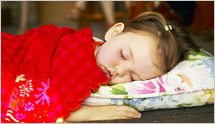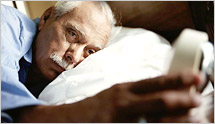The Takeaway
- Depending on our ability and opportunity to sleep, we may not always get the sleep we require.
- As we age and undergo a variety of developmental changes, our sleep patterns change as well.
- Predicting these changes and understanding why they occur can lead to longer and more restful sleep—and better health.
Although we all need to sleep, how we experience sleep can be quite varied. Some of the factors that influence our sleep are intrinsic to who were are, and some are caused by changes in our routines and circumstances. Age is an important factor that influences how long we sleep, when we want to go to bed and wake up, and how deeply we are able to sleep.
A Life of Change

Over a typical lifespan, the amount of time we spend each day sleeping declines. Newborns spend from 16 to 20 hours asleep each day. Between the ages of one and four, total daily sleep time decreases to about 11 or 12 hours. This gradual decline continues through childhood, such that an adolescent will need—though not necessarily get—about nine hours of sleep to function at his or her best. Adults through middle age need at least eight hours, and although the elderly may still require up to eight hours, they may struggle to obtain those hours in one block.
In addition to changes in sleep duration, sleep patterns also change as we age. In the beginning, as all new parents discover, a newborn's sleep is sporadic: the need to sleep and the need to eat cycle across the day and night, with little time for anything else. After three or four months, infants begin to develop a pattern in which sleep becomes consolidated into longer periods. Older infants and young children typically obtain their sleep during a solid nighttime session plus two or more daytime naps. Generally speaking, through the toddler years, naps become fewer in number and shorter in duration, and sleep becomes more consolidated during the night. By the age of six or seven, many children have stopped taking naps entirely. Their sleep is experienced much as it will be through adulthood: in a single consolidated block, most often at night.
Dr. Richard Ferber describes the typical changes in sleep from early childhood through adolescence.
In many cultures, napping continues to be a normal part of daily life for both young and old. This practice, which in Spanish-speaking countries is called a siesta, tends to be more common in the tropics than in more temperate latitudes. Naps in these cultures typically take place in mid-afternoon and coincide with the hottest time of day, as well as a lull in the brain's alerting signal that works to counteract the drive to sleep. As a consequence of these regular daytime naps, nighttime sleep is often shifted to a later hour than it is for societies or individuals that don't nap during the day.
Sleep Stage Variations
Although it may appear so from the outside, sleep is not a completely inactive state. During sleep, the brain’s activity changes in characteristic ways over the course of the night. These patterns have been classified into two main types of sleep: rapid-eye-movement (REM) sleep and non-rapid-eye-movement (NREM) sleep. NREM sleep is broken down into three distinct stages: N1, N2, and N3. These stages are characterized by increasingly larger and slower brain waves. N1 sleep is very light sleep; N2 is slightly deeper sleep; and N3, also called slow-wave sleep, is the deepest NREM sleep stage.
REM sleep, which is often associated with dreaming, is thought to assist in brain development, especially early in life. Not surprisingly, newborns and infants typically spend about twice as much time as adults in REM sleep. Interestingly, the neurological barrier that inhibits muscles in the legs and arms from contracting during REM sleep and prevents people from "acting out" their dreams is also not fully developed in newborns. Without full inhibition, brain activity associated with REM sleep can result in dramatic twitches and movements of an infant’s limbs. Some of these are strong enough to stir the child from sleep. Only during the second six months of life does the system develop sufficiently to inhibit dramatic body movements during REM sleep.

Sleep cycles, composed of REM and NREM sleep, last for about 50 minutes in children and 90 minutes in adults. Infants’ and children’s cycles contain a relatively large amount of slow-wave (N3) sleep—the non-dreaming, restorative kind that is also known as deep sleep. In early adulthood the amount of slow-wave sleep begins to decline. Elderly adults typically have relatively short periods of slow-wave sleep and fewer of them. In other words, sleep is lighter and more fragmented with brief arousals or longer awakenings throughout the night.
Sleep stages and other patterns are covered in much greater detail in Science of Sleep: What is Sleep.All in the Timing

As children pass into adolescence, both the stages of sleep and the sleep cycle remain largely unchanged. One thing that does change, however, is the timing of their sleep. Humans possess an internal 24-hour clock, also called the circadian pacemaker, that partly determines the time when people fall asleep and when they wake, as well as their alertness level while they are awake. Interestingly, due to changes in the circadian alerting system related to development, the preferred times for falling asleep and waking are typically delayed in adolescents. This leads to many high school students going to bed relatively late at night because their internal clock prevents them from feeling sleepy until later. However, school start times are usually much earlier than the typical adolescent's naturally preferred wake time. As a result, many students must wake at unusually early phases of their internal circadian cycle and after inappropriately short sleep duration. Also, exposure to artificial indoor light in the evening fools the internal clock into thinking it is earlier than it actually is, which can make this problem worse. Many students try to catch up on their sleep by sleeping late on the weekends, but this only shifts their internal clock further out of phase with their weekday schedule.
Another important change with aging results from changes in how the two systems that regulate the timing of sleep—the sleep-wake homeostat and the internal clock—interact with each other. Under normal conditions, these two systems keep us alert throughout the day and enable us to sleep throughout the night. As people age, however, the window during which the internal clock enables sleep narrows. This may explain why older people tend to wake up early in the morning and fall asleep earlier in the evening, and also why they may not be able to nap in the early part of the day.
Age-Related Sleep Problems
Given what we know, late childhood may well be the "golden age" of sleep during a lifetime. Beyond the age of 11 or 12, sleep disturbances begin to creep in. In fact, nearly 7 out of every 10 adults experience problems that affect sleep quality.
Dr. Jean Duffy describes some of the underlying causes of sleep problems in older adults.
A number of sleep problems are particular to adult women. Half of them report sleep disturbances during their menstrual periods; three-quarters of expectant mothers report that sleep is more disturbed during pregnancy; and many experience disrupted sleep during menopause, in part due to nighttime "hot flashes."
Insomnia and disrupted sleep in elderly people are a common side effect caused by many chronic medical conditions such as arthritis, congestive heart failure, depression, and gastroesophogeal reflux disorder. Respiratory disorders, such as sleep apnea, which cause multiple arousals during the night, also become more common as people age. Other problems, such as restless legs syndrome, which results in an uncontrollable need to move one's legs while drifting off to sleep, or periodic limb movements, which cause jerking of the feet or legs during the night, can make it difficult to fall asleep or lead to highly fragmented sleep. Unfortunately, sleep problems in older adults often go undiagnosed and untreated simply because many people believe sleep problems are a normal part of aging or that nothing can be done to help them sleep better. Thankfully, treating any underlying medical disorders can dramatically improve sleep.

Because most older adults are less able than younger adults to maintain sleep, the elderly suffer disproportionately from chronic sleep deprivation. Sleep deprivation may cause individuals to unintentionally nod off during daytime activities. Late afternoon naps can also reduce a person’s ability to sleep through the night, thus potentially worsening insomnia. Learning how the internal clock and sleep drive interact, and how they limit when good sleep can occur, can help people devise strategies that will help them maintain quality sleep as they age.
Find out more about the impact of sleep deficiencies in Consequences of Sleep Deficiency.
Learn about what you can do today to improve your sleep in Twelve Simple Tips to Improve Your Sleep.
And if your sleep difficulties don’t improve through good sleep hygiene, you may want to consult your physician or a sleep specialist. Learn more at When to Seek Treatment.